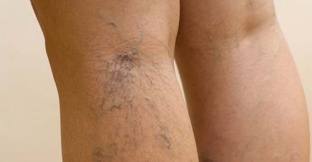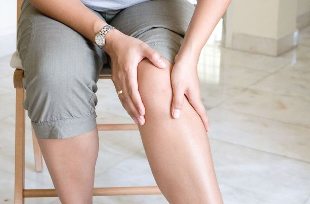Varicose veins reticular is common among many adults. As the disease manifests itself, and whether there are effective ways of therapeutic effects on diseased vessels?
What is it?

Reticular (from the Latin word reticulum — net) or varicose veins in the form of a grid is not a separate type of pathology, and reticular varicose form of the disease, its initial stage. It is characterized by the expansion of small superficial subcutaneous blood vessels and the appearance of telangiectasias.
Telangiectasia is visible under the skin plexus extended up to 0.5-1 mm of arterioles, venules and capillaries that manifest in the form of cyanotic-red spots with branches, resembling the form of a grid, spider-like plexus of veins.
The disease is diagnosed more often in women. According to the results of medical research, net varices detect from 35-45% of women and 15-20% of adult men.
Causes
The main reasons for the development of the disease:
- decrease in elasticity and density of the vascular wall.
- violation of circulation of blood;
- unsatisfactory work of the venous valves.
Among the factors that cause changes in the blood vessels that provide:
- the period of carrying a child, especially 5 to 9 month gestation, due to the increase in blood volume in the blood vessels, increased load on the legs, compression of the veins of the abdomen by the growing uterus;
- hormonal surges during pregnancy and menopause;
- genetic predisposition to weakness of the venous wall due to disruption of the structure of connective tissue;
- being overweight with increasing body mass index to 27 kg/m2, the probability of pathology is increased by 30%;
- career with a long stay in the standing, sitting, periodic lifting and carrying heavy loads (loaders, athletes, weightlifters, sellers, hairdressers, travelers);
- the wearing of corsets, belts that increase the pressure inside the peritoneum of tight jeans that constrict the blood vessels in the groin area;
- prolonged use of corticosteroids and hormonal birth control pills;
- diabetes, hypertension, dermatological diseases, including rosacea;
- fractures of limbs;
- excessive and prolonged sun exposure, Smoking;
- low amount of fiber in the diet leads to prolonged constipation, which contributes to varicose veins, lack of nutrients – weakening of vessel walls.
Symptoms
Basic characteristics of the initial stage of reticular veins:
- the appearance of a bluish-red telangiectasia — point, star, mesh patches of different sizes and brightness, which are often found on the ankles, behind the knees, on hips, after pressing, they pale, but immediately appear again;
- heaviness, tension in calf muscles, fatigue when walking.
The symptoms that occur if the disease develops:
- the spread of the legs to clean the skin, increasing the diameter of the capillaries;
- a feeling of fullness in the legs, tingling, "pins and needles" (paresthesia);
- cramps in calf muscles during the night or in the morning;
- nagging pain;
- mild edema of the legs, calves, legs in the evening, which disappears by morning;
- itching of the skin over the areas of extension, reticular vessels;
- burning on the line of the affected vessel;
- pain on compression of calf muscles;
- the gradual bulging of the subcutaneous veins, the formation of bumps with a size of 2-4 mm;
- the manifestation of brown or white spots in the course of the blood vessels, swelling, redness.
If time does not take measures to identify the causes of the disease and addressing its first signs, pathology will move into a stage of steady expansion of the veins. In this case, under the skin formed vascular knots, the vessels become tortuous, walking hurts.
The progression of the disease is fraught with consequences – acute thrombophlebitis, non-healing trophic ulcers, the development of venous insufficiency, bleeding, thrombosis.
Diagnosis
Definition of reticular veins is not difficult for a specialist. To assess the prevalence of abnormal process, the degree of hemodynamic instability (blood flow), the velocity distribution of blood flow, detect signs of thrombosis, use diagnostic techniques:
- ultrasound examination;
- duplex procedure;
- ultrasonic dopplerography of veins;
- x-ray, radionuclide methods.
Treatment

To treat varicose veins must mesh immediately after diagnosis to prevent getting the disease in the chronic phase, complications.
Most methods of treatment relieves the patient from the external signs of the disease. To cure pathology, it is necessary to conduct a medical examination to find the root cause of the weakness of blood vessels and blood flow disorders.
Compression stockings
When the reticular varicose veins or subcutaneous nets patients and healthy people with a tendency to the disease need to purchase compression socks, stockings. Targeted therapeutic compression is an important part of treatment.
Compression hosiery is designed to create in different parts of the foot to different pressure.
The greatest pressure falls on the ankle since the blood work turns up. Stocking supports and compresses the dilated vessels, helping blood flow, eliminating stasis. In the thigh compression is reduced almost 2.5 times, as in this region the load on vessels less.
Constant mild compression of the veins preventing the expansion, normalizes microcirculation, eliminates puffiness, prevents blockage of the lumen by blood clots.
Other bezoperatsionnye therapies
Among other common conservative methods of treatment of varicose veins reticulate micro-sclerotherapy and laser photocoagulation.
Micro-sclerotherapy is the most common method for recovery of reticular veins and eliminate of telangiectasia. During the procedure use a special substance that no cutting needle is introduced into the vessel. Substance causes micro damage to the internal walls of the vein or capillary. Injuries are overgrown, narrowing the internal lumen. On the site of the former vessel is formed by a strand of connective tissue (like scar), which itself resolved within 10-12 months.
Sclerotherapy practice in the liquid art when the vessel is introduced into the liquid composition, or in the more advanced technology Foam-form sclerotherapy (foam). In the second embodiment, the current solution micro-foam, which is distributed with the affected vessel.
The procedure is often carried out under video surveillance, controlling the process using the duplex scanner.
Laser coagulation of blood vessels – simultaneously gentle and effective method ensures the removal procedure is quick, bloodless, without affecting healthy tissue. The procedure is performed under ultrasound control.
Through a puncture in the skin, the doctor inserts into the lumen of the diseased vein, a thin catheter with a laser fiber. Under the high temperature from the laser beam, the walls of the affected blood vessels are sealed.
Depending on the number of vascular branching in the sclerotherapy and laser treatment lasts 15-60 minutes. To Express the therapeutic outcome requires from 2 to 5 sessions.
Treatment with sclerotherapy and the laser beam is carried out more frequently on an outpatient basis under local anesthesia. The patient can leave the clinic in 2-4 hours. After the procedure the treated area, apply a bandage, bandage for 4-10 days. Compression stockings are from 7 to 30 days. In 2-4 days the patient returns to normal rhythm of life.
After treatment is recommended 3-4 months:
- drink up to 2-3 liters of fluid per day to maintain fluid properties of blood;
- take all medications prescribed by a doctor;
- not to neglect the compressive knitwear with long walks, stay at the working place in standing or sitting;
- to walk a lot;
- to abandon high heels.
Other methods of treatment of reticular veins include 3 method of therapy.
- Radiofrequency obliteration of the vessels (equipment EVRF, RFO). Radio wave radiation is generated by the medical device, fixed on the extremity of the catheter. Under the action of radio waves of the wall of the vein stick together, the vein disappears, and the tissue formed in its place, resolves.
- Thermal occlusion micro pulse steam (SVS technique). The technique, developed by French physicians. Involves treating of the lumen of the varicose vessel, warm vapor coming through introduced catheter. The steam penetrates into hard to access, anatomically convoluted vascular branches, narrowing and "glue" the capillaries and venules.
- The method of treatment with biological glue (Venaseal) – a new highly effective and safe method. Often used in the treatment of reticular veins in the initial phase of expansion. Into the vessel under ultrasound guidance using a syringe and catheter is a special glue. Vienna is compressed dramatically, the walls are glued together. Vascular subcutaneous mesh disappear almost immediately. When processing small vessels do not need to wear compression stockings after the procedure. Allergic reactions are excluded because special glue is a natural product.
Surgical treatment

Phlebectomy surgery for varicose veins of the lower extremities. It is performed when the diameter of the enlarged receptacle up to 10 mm.
Through a small incision the surgeon removes the surface vessel, which bandages and cuts. The surgery is performed under local anesthesia. The operation is performed with minimal tissue damage, leaves no cosmetic defects.
The popular treatment
Recipes for home-made medicine in the treatment of reticular veins are used in addition to therapy. Good result give in a joint application with drugs, pharmaceutical ointments, wearing compression hosiery, especially in the first stage of telangiectasia.
- Untreated ripe young fruits of chestnut (50 g) finely chopped, pour a glass of vodka and leave for 20 days. After straining 3 weeks three times a day for 15-20 drops. After 2 weeks break can be repeated.
- Cabbage leaves rinse and put in the cold for 24 hours. Before sleep to dry skin of the affected area, apply the letter and not tight bandage. The treatment is carried out every day for 1-2 months.
- Dry birch buds sleep in a jar 0.5 litre by 1/3. Pour vodka to the brim, insist 10 days. Tincture gently RUB the areas with telangiectasia.
Prevention
To avoid the appearance of subcutaneous "stars" you should follow the guidelines:
- do not carry heavy objects, including bags of food;
- do not take hot baths, no saunas;
- wearing elastic tights or stockings with compression;
- at home more often to keep the legs in a horizontally raised position;
- sitting at work to create conditions so that the lower limbs were in a horizontal position every 2-3 hours to do a 10-minute break for special exercises to enhance blood flow;
- to move more, to Hiking, to not overdo it;
- to do contrast baths or shower for your feet;
- use a healing ointment for the prevention of venous changes, taking medicines for the strengthening of vascular tone, on the recommendation of phlebologist;
- to swim in the pool with warm water;
You need to adjust the diet to get rid of excess body weight, to stop Smoking.




































